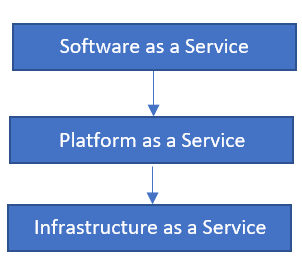Cloud technology has emerged as a serious platform for service delivery for today’s businesses. I spend most my day working with clients and outlining options on how to solve real business challenges using cloud technology. As a result, I’m sure my perspective is heavily biased. However, I’ll take a stab here at being even handed while answering a question many of my clients have that you might too: Is cloud technology a good fit for my business?
Before I give my answer, let’s forget about public cloud, private cloud, edge computing, and on premise data centers completely for a moment. Let’s go back to the beginning of why you’re in business in the first place. Most businesses are begun to manufacture goods or deliver services to consumers. Many are designed to deliver a profit to their owner or investors and most have people behind them who are passionate about the outcomes and processes. We have many other organizations such as education and government who operate with a mission for the community and are more focused on behavioral outcomes and compliance. In summary, MOST businesses in the world are NOT data center businesses. This concept of what business you’re in and why you are in it should be germane to your decision making with regards to technology topics.
How did I get involved in the data center business after all?
Most cultures around the world have one thing in common: A Genesis story. This is the story of how it all started and it tends to be connected to how things work today. Every organization has that person or a few people who can tell the Genesis story about the time before computers existed in their organization. Many people today just assume their organization will have a data center with servers, storage, networking, and information technology people to help with desktops, mobile devices, applications, and whatever else they need. It’s normal. In the beginning (as the stories start), our businesses have a need to deliver services/goods and the business leaders purchase APPLICATION SOFTWARE from specialized vendors to make this happen more quickly and efficiently. This application software delivers SERVICES to the business. The delivered services may serve financial, manufacturing, communications (such as e-mail, instant messaging, etc.), security, or another of the hundreds of functionalities a business may need. The key is the business purchased SOFTWARE to receive a SERVICE. This SOFTWARE is typically packaged as an application. Applications require servers to support them, storage to retain data, and a network to connect all the components. As a result, the initial desire to purchase an application to provide service to your business operations ends up resulting in the hiring of information technology engineers to build/maintain a compute environment for the application and train people to use it. Figure 1 represents a simple outline of the decisions which have been made millions of times to continue manual methods or attain more efficient services by purchasing software applications.
The result of this decision to attain more efficient services by purchasing software applications is the root cause of most businesses getting into the data center business. It starts with a server, grows to a server farm, and then the next thing you know the business has an entire I.T. staff, a dedicated and managed facility, and things such as virtualization, deduplication, and a host of other functionalities they never asked for when they set out.
The only constant is change
Being humans, we’re not perfect. However, we are in an endless strive for perfection. Also, we’re creative. That means we come up with new ways to do things. This strive for perfection (i.e. defect reduction) and new ways to do things (i.e. features) leads to a constant release of software. This software becomes more and more powerful which means it requires more and more compute/storage. This, of course, leads to things like “compatibility” discussions where certain versions of software require certain versions of hardware. Having made the decision to engage software for our services, we feel we have no choice but to UPGRADE. Figure 2 below outlines the endless upgrade cycle businesses goes through. Keep in mind that this cycle, in general, repeats for EVERY APPLICATION/SERVICE at least every three years, and sometimes more often than that.
Maintaining this endless upgrade cycle is costly. Businesses must pay for new licenses, more information technology people, software costs, hardware costs, utility bills, etc. AND manage the disruption to their business caused by the changes. This cyclical cost and disruption are important things to consider. Keep in mind that by enrolling in cloud services, a business SHOULD end this cycle of upgrades and disruption while still getting resolutions to bugs and achieving new capabilities.
After years of building their own, many businesses decide they still need the services of their applications but want to get out of the data center operations business. In general, they will pay someone else to HOST the servers, storage, and business networks. This HOSTING business has been a valuable service for many organizations for more than twenty years. When engaging hosting, the compute, network, and storage functions are replaced with a monthly cost. However, the endless application upgrade cycle continues, as does the underlying dependencies which continue to evolve, which also includes working with the hosting provider as a function of the business.
At this point, it’s sometimes still hard to remember that YOU’RE NOT in the data center business.
There’s Got to be Another Way
After seemingly endless upgrade cycles and many information technology and business analyst hires, we start asking ourselves, “Is there another way?”
For many years the answer was no, this is how everyone is doing it.
Fast forward to 2017.
When discussing a technology investment, I ask my clients this question: “If you were starting a business today, how much of your startup capital would you invest in a data center?” The answer is nearly always a resounding NONE. The follow-on question is obvious. If a customer wouldn’t spend any money on a data center when making new investments, why do they continue the upgrade cycle? The answers typically fall into a couple of categories:
- Minimize disruption to the business
- Concerns over the security of data
- Concerns over monthly recurring costs
- Availability of cloud software that does exactly what they want
- Achieving the benefit of current investments
With all of this stated, let’s answer the question which started this blog: Is cloud technology a good fit for my business? To answer that question, ask yourself the following questions:
- Do you want to be in the data center business?
- Do your business requirements mandate that you keep your applications and data on premise because only with the dedicated efforts of your team can you keep the control you need?
If the answer is NO to both questions, then yes, cloud technology is most likely a good fit for your business. The question now becomes one of strategy to address your concerns and engage the cloud so that you can promptly get out of the data center business.
Figure 3 outlines how you should engage cloud technology to achieve the most financial and service benefit. You should almost always leverage Software as a Service (SaaS) solutions when you can find ones that fit your needs. If SaaS isn’t an option, do your best to leverage a Platform as a Service (PaaS) solution, but ensure that the cost model makes sense. Lastly, deploy your applications on a scalable Infrastructure as a Service (IaaS) solution. Keep in mind that your applications deployed on IaaS should be cloud ready (i.e. scalable up and down) so that you aren’t just running virtual machines in the cloud like you would in a hosted scenario or on premise. A word of advice: Be cautious about leveraging IaaS for simple hosting. In many cases, you would be better off remaining on premise in your own data center or using a hosting provider from a cost perspective.

ince 2012, organizations have been asking themselves where the best location is to invest in technology services for their business. While we had a short period of equivalency in 2015, 2017 has been the definitive year for engaging cloud technology first and then justifying IF and WHY a solution must be deployed on premises later.

There are a variety of cost models and methods to determine whether or not cloud technology is a good decision for your business. You probably started your business to focus ON your business and not to become a data center operator. My advice is to regain focus on your business and avoid the capital expenses and the hassle of endless upgrade cycles. In the end, your business outcomes and your customers will thank you.
For more from Michael Chapman, head over to his blog.




